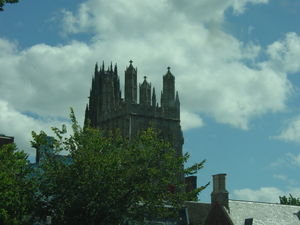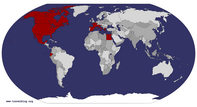Advertisement
Published: October 20th 2007

 New Haven
New Haven
New Haven, Connecticut - United States of AmericaSep 15, 2007
City official name :New Haven
Founded date : Location :Connecticut State
Elavation :? ft (? m)
Area :Approximately ? square miles (? km²).
Facts :New Haven is the second- or third-largest municipality in Connecticut, after Bridgeport and possibly Hartford, with a core population of about 124,000. "New Haven" also often refers to the wider New Haven metropolitan area, which has nearly 600,000 inhabitants in the immediate area (and is also considered part of the New York metropolitan area, which has about 18 million). It is in New Haven County, on New Haven Harbor, on the northern shore of Long Island Sound.
Founded in 1638, New Haven was laid out in a grid of four streets by four streets creating what is now commonly known as the "Nine Squares," now the center of Downtown New Haven. The city instituted the first public tree planting program in America, eventually producing a canopy of mature trees (including some large elms) that gave New Haven the nickname "The Elm City."
The city is best known as the home of Yale University and the National Historic Landmark New Haven Green. Along with Yale, healthcare

 New Haven
New Haven
New Haven, Connecticut - United States of America(hospitals, biotechnology), professional services (legal, architectural, marketing, engineering), financial services and retail trade form the base of the economy. Since the mid-1990s, the city's downtown area has seen extensive revitalization.
Before European arrival, the New Haven area was the home of the Quinnipiac tribe of Native Americans, who lived in villages around the harbor and subsisted off local fisheries and the farming of maize. The area was briefly visited by Dutch explorer Adriaen Block in 1614. Dutch traders set up a small trading system of beaver pelts with the local inhabitants, but trade was sporadic and the Dutch did not settle permanently in the area.
In April 1638, five hundred Puritans who left the Massachusetts Bay Colony under the leadership of the Reverend John Davenport and the London merchant Theophilus Eaton sailed into the harbor. These settlers were hoping to establish a better theological community than the one they left in Massachusetts and sought to take advantage of the excellent port capabilities of the harbor. The Quinnipiacs, who were under attack by neighboring Pequots, sold their land to the settlers in return for protection.
By 1640, the town's theocratic government and nine square grid plan were in

 New Haven
New Haven
New Haven, Connecticut - United States of Americaplace, and the town was renamed Newhaven from Quinnipiac. However, the area north of New Haven remained Quinnipiac until 1678, when it was renamed Hamden. The settlement became the headquarters of the New Haven Colony. At the time, the New Haven Colony was separate from the Connecticut Colony which had been established to the north focusing on Hartford. Economic disaster struck the colony in 1646, however, when the town sent its first fully loaded ship of local goods back to England. This ship never reached the Old World, and its disappearance stymied New Haven's development in the face of the rising trade power of Boston and New Amsterdam. In 1660, founder John Davenport's wishes were fulfilled and Hopkins School was founded in New Haven with money from the estate of Edward Hopkins.
In 1661, the judges who had signed the death warrant of Charles I of England were pursued by Charles II. Two judges, Colonel Edward Whalley and Colonel William Goffe, fled to New Haven to seek refuge from the king's forces. John Davenport arranged for these "Regicides" to hide in the West Rock hills northwest of the town. A third judge, John Dixwell, joined the other regicides at

 New Haven
New Haven
New Haven, Connecticut - United States of Americaa later time.
New Haven became part of the Connecticut Colony in 1664, when the two colonies were merged under political pressure from England, according to folklore as punishment for harboring the three judges (in reality, done in order to strengthen the case for the takeover of nearby New Amsterdam, which was rapidly losing territory to migrants from Connecticut). It was made co-capital of Connecticut in 1701, a status it retained until 1873. In 1716, the Collegiate School relocated from Old Saybrook to New Haven and established New Haven as a center of learning. In 1718, the name of the Collegiate School was changed to Yale College in response to a large donation from Welsh merchant Elihu Yale.
For over a century, New Haven citizens had fought alongside British forces, as in the French and Indian War. As the American Revolution approached, General David Wooster and other influential residents hoped that the conflict with Britain could be resolved short of rebellion. But on April 23, 1775 (still celebrated in New Haven as Powder House Day), the Second Company, Governor's Foot Guard, of New Haven entered the struggle against the British. Under Captain Benedict Arnold, they broke into the

 New Haven
New Haven
New Haven, Connecticut - United States of Americapowder house to arm themselves and began a three-day march to Cambridge, Massachusetts. Other New Haven militia members were on hand to escort George Washington from his overnight stay in New Haven on his way to Cambridge. Contemporary reports, from both sides, remark on the New Haven volunteers' professional military bearing, including uniforms.
British forces under General William Tryon raided the 3,500-person town in July of 1779 , but did not torch it as they had with Danbury in 1777 , or Fairfield and Norwalk a week after the New Haven raid, leaving many of the town's colonial features preserved.
New Haven was the original settlement in New Haven Colony; over time other new towns separated from its territory and incorporated. The following is a complete list of towns established from parts of the original New Haven settlement. Connecticut Register and Manual
Wallingford in 1670
Cheshire created from Wallingford in 1780
Meriden created from Wallingford in 1806
Branford in 1685
North Branford created from Branford in 1831
Woodbridge in 1784 (also partly from Milford)
Bethany created from Woodbridge in 1832
East Haven in 1785
Hamden in 1786
North Haven in 1786
Orange in 1822 (also partly from

 New Haven
New Haven
New Haven, Connecticut - United States of AmericaMilford)
West Haven created from Orange in 1921
New Haven was incorporated as a city in 1784 , and Roger Sherman, one of the signers of the Constitution and author of the "Connecticut Compromise," became the new city's first mayor.
The city struck fortune in the late 18th-century with the inventions and industrial activity of Eli Whitney, a Yale graduate who remained in New Haven to develop the cotton gin and establish a gun-manufacturing factory in the northern part of the city near the Hamden town line. That area is still known as Whitneyville, and the main road through both towns is known as Whitney Avenue. The factory is now the Eli Whitney Museum which has a particular emphasis on activities for children, and exhibits pertaining to the A. C. Gilbert Company. Whitney pioneered the replacement of hand-shaped piecework with industrial mass-production and interchangeable parts and was the first defense contractor. His methods made early Connecticut a powerful manufacturing economy; so many arms manufacturers sprang up that the state became known as 'The Arsenal of America'. It was in Whitney's gun-manufacturing plant that Samuel Colt invented the automatic revolver in 1836.
The Farmington Canal, created in the

 New Haven
New Haven
New Haven, Connecticut - United States of Americaearly 1800s, was a short-lived transporter of goods into the interior regions of Connecticut and Massachusetts, and ran from New Haven to Northampton, Massachusetts.
New Haven was home to one of the important early events in the burgeoning anti-slavery movement when, in 1839, the trial of mutineering Mendi tribesmen being transported as slaves on the Spanish slaveship Amistad was held in New Haven's United States District Court. There is a statue of Joseph Cinqué, the informal leader of the slaves, beside City Hall. See "Museums" below for more information.
The Civil War boosted the local economy with wartime purchases of industrial goods. After the war, New Haven's population grew and doubled by the start of the 20th century, most notably due to the influx of immigrants from southern Europe, particularly Italy. Today, roughly half the populations of East Haven, West Haven, and Hamden are Italian-American.
New Haven's growth continued during the two World Wars, with most new inhabitants being African Americans from the South and Puerto Ricans. The city reached its peak population after World War II. The area of New Haven is only 17 square miles (44 km²), encouraging further development of new housing after 1950

 New Haven
New Haven
New Haven, Connecticut - United States of Americain adjacent, suburban towns. Moreover, as in other US cities in 1950s, New Haven began to suffer from an exodus of middle-class workers.
In 1954, then-mayor Richard C. Lee began some of the earliest major urban renewal projects in the United States. Certain sections of Downtown New Haven were destroyed and rebuilt with new office towers, a hotel, and large shopping complexes. Other parts of the city were affected by the construction of Interstate 95 along the Long Wharf section, Interstate 91 and the Oak Street Connector. The Oak Street Connector (Route 34), running between Interstate 95, downtown and The Hill neighborhood, was originally intended as a highway to the city's western suburbs but, due to neighborhood opposition, was only completed as a highway to the downtown area, with the area to the west becoming a boulevard.
From the 1960s through the early 1990s, central areas of New Haven continued to decline both economically and in terms of population despite attempts to resurrect certain neighborhoods through renewal projects. In the mid-1990s New Haven began to stabilize and grow, though poverty in some central neighborhoods remains a problem.
Yale University, at the heart of downtown, is one of

 New Haven
New Haven
New Haven, Connecticut - United States of Americathe city's best known features and its largest employer. New Haven is also home to other centers of higher education, including Southern Connecticut State University and Albertus Magnus College. The University of New Haven is located not in New Haven but in neighboring West Haven. Quinnipiac University is located north of New Haven, in the towns of Hamden and North Haven. Gateway Community College has a campus in New Haven, located in the Long Wharf district.
Advertisement
Tot: 0.084s; Tpl: 0.013s; cc: 13; qc: 32; dbt: 0.0458s; 1; m:domysql w:travelblog (10.17.0.13); sld: 1;
; mem: 1.1mb










